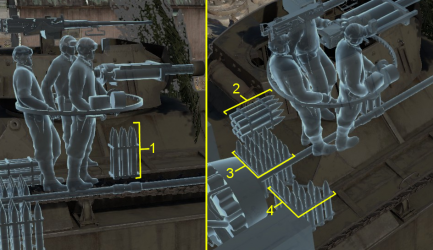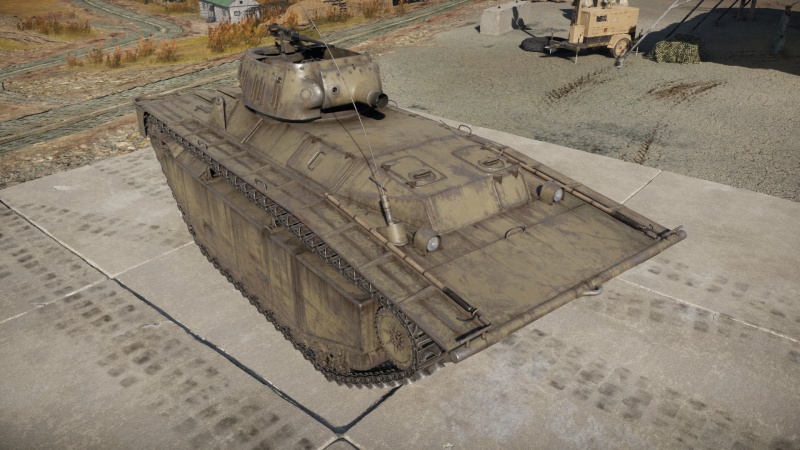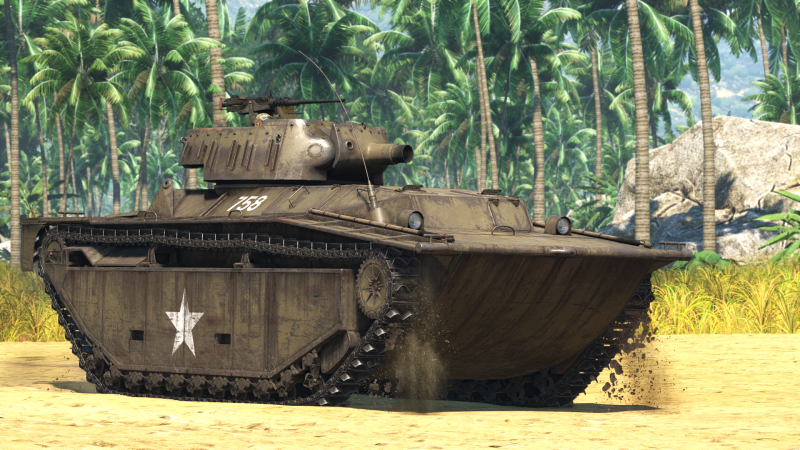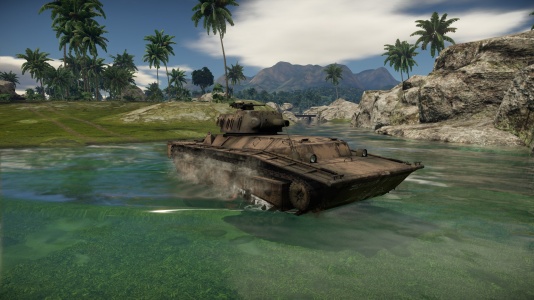LVT(A)(4)
| This page is about the American light tank LVT(A)(4). For other versions, see LVT (Family). |
Contents
Description
The Amphibious Vehicle, Tracked, Armoured, Mark 4 - LVT(A)(4) is the fourth armoured, infantry support variant of the Amphibious Vehicle, Tracked (LVT) family. The 37 mm M6 tank gun of the LVT(A)(1) was deemed insufficient for fire support by the U.S. Marines, thus the turret of the 75 mm Howitzer Motor Carriage M8 (HMC), also known as the M8 "Scott", was modified to produce the LVT(A)(4). A 12.7 mm M2HB Browning heavy machine gun was mounted on the ring mount above the turret's rear. The two 7.62 mm M1919A4 light machine guns mounted on ring mounts on the aft deck behind the turret were removed. During World War II, a total of 1,890 units were built. The U.S. Army received 1,307 units, the British Army received 50, and the remaining units were used by the U.S. Marines.
Introduced during Update 1.97 "Viking Fury" as a reward for the 2020 Victory Day event, the LVT(A)(4) is a premium beginner light tank under the U.S. Army ground forces. It has similar firepower to the M8 "Scott" but has the unique ability to traverse across water, which most tanks do not have. To keep afloat in the water, the tank is made of relatively thin steel plates and provides little protection against anything heavier than light machine gun fire. Due to the low muzzle velocity of the rounds, it is possible to shoot over low obstacles in some situations, allowing players to damage other lightly armoured vehicles without exposing themselves. Finally, the 12.7 mm M2HB Browning heavy machine gun can be highly effective while dealing with other lightly armoured vehicles as well as low and slow-flying aircraft in the beginner ranks.
General info
Survivability and armour
Like its reserve rank brother, the LVT(A)(4) is a big tank with lots of space between modules and crew. This allows some surprising survivability when facing tanks that have low-calibre single shot guns, and even some automatic cannons such as the ones equipped on the Panzer II's. The LVT(A)(4)'s biggest adversary is HE or HEAT ammunition, such as the kind fired from the Chi Ha's 57 mm and Panzer IV's 75 mm. The LVT(A)(4)'s hull armour is very thin, and is only effective against rifle-calibre machine guns. The turret armour is a different story. With decent angles and relatively good thickness the turret can cause a fair amount of shots to ricochet or bounce. The turret is open-topped however, and is vulnerable to artillery and air attacks.
Armour type:
- Rolled homogeneous armour
- Cast homogeneous armour (gun mantlet)
| Armour | Front (Slope angle) | Sides | Rear | Roof |
|---|---|---|---|---|
| Hull | 6.35 mm (84°) Upper glacis 12.7 mm (31°) Upper plate 6.35 mm (40°-80°) Lower glacis |
6.35 mm Top 6.35 + 6.35 mm Bottom |
6.35 mm | 6.35 mm |
| Turret | 38.1 mm Turret front 12.7 mm Gun mantlet |
25.4-38.1 mm | 25.4 mm | |
| Commander's MG Ring | 25.4 + 11.75 mm | |||
Notes:
- The gun barrel (10 mm) is wrapped in 12.7 mm of armour
- The turret for the most part is open-topped, but at the very rear there are 9.5 mm of armour
- Tracks and Suspension - 15 mm
- Turret Ring - 12.7 mm + 6.35 mm Turret Ring Guard (Hull)
- Fenders - 6.35 mm
Mobility
| Game Mode | Max Speed (km/h) | Weight (tons) | Engine power (horsepower) | Power-to-weight ratio (hp/ton) | |||
|---|---|---|---|---|---|---|---|
| Forward | Reverse | Stock | Upgraded | Stock | Upgraded | ||
| Arcade | Expression error: Unexpected * operator. | 387 | Expression error: Unexpected round operator. | __.__ | |||
| Realistic | 221 | Expression error: Unexpected round operator. | __.__ | ||||
The LVT's mobility is adequate. On hard surfaces it easily reaches its top speed of around 38 km/h. On soft surfaces it needs more time to accelerate, and the top speed is lowered. The reverse speed is extremely poor, which can cause you to take unnecessary hits. The hull traverse is great, allowing you to quickly change direction, however a downside is that when you turn the hull to aim, you might over-turn and swing the gun past the target, increasing the aiming time which can be fatal.
Due to its big and tall tracks, the LVT can drive over some obstacles that are too tall for normal-sized tanks.
Modifications and economy
Armaments
Main armament
| 75 mm M2 Howitzer | Turret rotation speed (°/s) | Reloading rate (seconds) | |||||||||||
|---|---|---|---|---|---|---|---|---|---|---|---|---|---|
| Mode | Capacity | Vertical | Horizontal | Stabilizer | Stock | Upgraded | Full | Expert | Aced | Stock | Full | Expert | Aced |
| Arcade | 46 | -20°/+40° | ±180° | N/A | 5.71 | 7.91 | 9.60 | 10.62 | 11.29 | 4.29 | 3.80 | 3.50 | 3.30 |
| Realistic | 3.57 | 4.20 | 5.10 | 5.64 | 6.00 | ||||||||
Ammunition
| Penetration statistics | |||||||
|---|---|---|---|---|---|---|---|
| Ammunition | Type of warhead |
Penetration @ 0° Angle of Attack (mm) | |||||
| 10 m | 100 m | 500 m | 1,000 m | 1,500 m | 2,000 m | ||
| M48 shell | HE | 10 | 10 | 10 | 10 | 10 | 10 |
| M66 | HEAT | 89 | 89 | 89 | 89 | 89 | 89 |
| Shell details | ||||||||||||
|---|---|---|---|---|---|---|---|---|---|---|---|---|
| Ammunition | Type of warhead |
Velocity (m/s) |
Projectile mass (kg) |
Fuse delay (m) |
Fuse sensitivity (mm) |
Explosive mass (TNT equivalent) (g) |
Ricochet | |||||
| 0% | 50% | 100% | ||||||||||
| M48 shell | HE | 381 | 6.3 | 0 | 0.1 | 666 | 79° | 80° | 81° | |||
| M66 | HEAT | 304 | 6.02 | 0.05 | 0.1 | 548.13 | 62° | 69° | 73° | |||
| Smoke shell characteristics | ||||||
|---|---|---|---|---|---|---|
| Ammunition | Velocity (m/s) |
Projectile mass (kg) |
Screen radius (m) |
Screen deploy time (s) |
Screen hold time (s) |
Explosive mass (TNT equivalent) (g) |
| M64 | 381 | 6.9 | 13 | 5 | 20 | 50 |
Ammo racks

| Full ammo |
1st rack empty |
2nd rack empty |
3rd rack empty |
4th rack empty |
Visual discrepancy |
|---|---|---|---|---|---|
| 46 | 41 (+5) | 32 (+14) | 12 (+34) | 1 (+45) | No |
Machine guns
| 12.7 mm M2HB | ||||
|---|---|---|---|---|
| Mount | Capacity (Belt) | Fire rate | Vertical | Horizontal |
| Pintle | 400 (200) | 576 | -5°/+70° | ±180° |
Usage in battles
The LVT(A)(4) is a fantastic fighting vehicle, it has a powerful 75 mm cannon attached to an LVT chassis is a great platform to fire on and giving its high profile, it is well built to fire over walls and other impediments. It is easy to hide the hull on some maps, like Abandoned Factory or Poland. One of the biggest issues, however, is that the vehicle is very easy to destroy with overpressure, so be very wary of vehicles firing powerful HE or HEAT shells such as the Spj fm/43-44 or the Sturmpanzer II, because if they get a shot off on your tank it will be destroyed. However, with the .50 cal machine gun, if enemies miss or do not destroy your vehicle, you can fire off a few bursts and destroy their vehicles.
Pros and cons
Pros:
- Good speed and manoeuvrability
- Five crew members with huge space between them increases survivability, especially when most guns it faces have small calibre and little explosive filler (e.g. the Stuart's 37 mm)
- Amphibious, meaning it can launch surprise attacks using rivers
- Amazing -20° gun depression allows excellent mountain combat ability
- Short reload time
- High penetration HEAT projectile
- High explosive filler will overpressure open-topped vehicles
- Heavy MG can effectively damage light vehicles and low-flying planes
Cons:
- Huge and tall hull makes it easy to be seen/shot at
- Very thin armour, can be penetrated by any cannon/heavy MG
- Easily destroyed with overpressure by large-calibre HE or HEAT shells, artillery strikes or air-dropped bombs
- Shells have low velocity which is a disadvantage in long range combat
- The crew in the open topped turret are very close together, meaning they can be taken out in a single shot or by aircraft
- Bad turret rotation, meaning it cannot respond to flankers in time
- Very slow reverse speed can prevent it from retreating back to cover in time
History
Development and Design
The vehicle's origins is from a swamp-access vehicle called the Alligator made for civilians. Donald Roebling, its developer, built an improved version of his vehicle with better speed in water. The United States Marine Corps became interested in this amphibious design as they began drawing up their amphibious warfare doctrine. They requested a more sea-worthy version of the vehicle for use in their military operations. Though Roebling and the Navy were reclusive on that idea (the Navy believes they have the current vehicle in store already), the idea brought fruit when World War II broke out in Europe and Roebling created a military version. After a few trials with improvements like a stronger engine, the Bureau of Ships placed a contract for 100 of these vehicles with all-steel armour. The first ones arrive in July 1941, with 200 more ordered before the initial contract was finished. The vehicle design was adopted and designated the LVT, with many different variants of the vehicle being produced throughout the war.
The first version of the LVT, the LVT-1, could carry 18 men or 4,500 pounds of equipment. The Marines first used the LVT-1 in Guadalcanal with 128 available to 1st Marine Division. Usage in the field revealed that the LVT was too thinly armoured for a rapid deployment back and forth the ships and landing site, but the Marines saw the vehicle's potential as an assault vehicle. So in June 1941, the Marines push forward with a Roebling design of the LVT armed with a gun turret. In order for this to be possible, the LVT underwent a redesign into the LVT-2 "Buffalo", which had a new powertrain and suspension to allow better performances on land and able to carry up to 6,950 pounds in equipment.
Early on it became clear that the LVTs that were in production - which were usually armed with only machine guns - did not have the firepower necessary to support the infantry, especially when facing enemy pillboxes, bunkers, and other entrenched positions used by the Japanese Army. In order to solve this problem, a fire support vehicle based on the LVT-2 was designed. It had a turret that was very similar to the turret of the M3 Stuart light tank. Before the introduction of the better armed LVT(A)-4 in 1944, 510 LVT(A)-1 were built by the Food Machinery Corporation.
The LVT(A)-1 was based on the LVT-2, but with a number of changes to make it a support vehicle. The LVT(A)-1 was fitted with a turret very similar to that of the M3 Stuart, and it was armed with the same 37 mm M6 cannon with 10 degrees of gun depression and 25 degrees of elevation. The main gun was fitted in the M4 mount, and there was a coaxial .30 cal (7.62 mm) machine gun. At the rear of the vehicle, two .30 cal Browning M1919A4 machine guns were fitted, and the gunners were protected by standard Navy gun shields. The deck was armoured, and the vehicle was fully enclosed. The front of the turret had 51 mm (2-in) of armour, and the ammunition was stored a number of racks throughout the vehicle. The vehicle had a crew of six; a commander and gunner in the turret, the driver and machine gunner in the front of the crew compartment, and two machine gunners at the rear of the vehicle. The LVT(A)-1 was a pure fire support vehicle, as there was no room inside to transport personnel or cargo. All the other features of the LVT(A)-1 were the same as on the LVT-2.
The LVT(A)-4 was essentially just an LVT(A)-1 but equipped with a different turret. It was still based on the LVT-2, but it has the turret of the 75 mm Gun Motor Carriage M8 "Scott" instead of the turret of the M3 Stuart light tank. Additionally, the two rear machine gun positions were removed; this reduced the crew to five, with the commander, gunner, and loader in the turret and the driver and co-driver in the front crew compartment. In total, 1,890 LVT(A)-4 vehicles were built, and they largely replaced the LVT(A)-1 in service. The 75 mm gun was more effective against fortified positions, but the 37 mm gun of the LVT(A)-1 was as effective or more effective against enemy armour. But, the main goal of the LVT(A)-1 and -4 was to support the infantry, not to destroy enemy armour - which is why the LVT(A)-4 was more effective.
The LVT(A)-4 was itself the basis of an improved fire support version of the LVT, the LVT(A)-5. This was an improved model of the LVT(A)-4. It featured a gyro-stabilizer for the main gun, and a powered turret. In the late 1940s many LVT(A)-5 received additional armour plating. A total of 269 LVT(A)-5 were produced.
Service
The first usage of the LVT family is as a cargo carrier in Guadalcanal, it was unarmoured at the time and only had machine guns as their main armaments. Their next usage was in Tarawa, which saw the first usage of the newly designed LVT-2. The vehicles in both cases carried ammunition, troops, and wounded back and forth the ships and the beach. After Tarawa, the LVT inventory increased by the battalion, as well as the appearance of the gun-armed LVT(A)-1 and LVT(A)-4. The LVT family continued to see service in Bougainville, the Marshall Islands, Saipan, Peleliu, Leyte (its largest usage in the war), Iwo Jima, and Okinawa. The LVTs also saw use in South East Asia in use by the British, but they never saw combat action.
Outside the Pacific, the LVT also saw use in the European Theater of Operations. Their first usage was in North Africa in November 1942 during Operation Torch to land troops, where its best usage was to get stranded landing boats back into action. The LVTs were also given to the British as part of Lend-Lease. The LVTs were used in the Normandy landings and other operations in Europe such as crossing the Rhine River in Germany and Po River in Italy.
After World War II, the LVTs continued to see action in the multiple conflicts in the world. A number were given to the Chinese Nationalists in the Chinese Civil War by America. Many of these were captured by the Chinese PLA, with some converted to use a 75 mm howitzer or a ZIS-2 anti-tank gun. The Americans used a number of LVT vehicles in the Korean War, notably the landing at Inchon and the attack on Seoul. The French also used American-supplied LVTs during the Indochina War and the Suez Crisis.
Media
- Skins
- Images
- Videos
See also
- Related development
External links
| Food Machinery Corporation (FMC) | |
|---|---|
| Amphibious AFVs | LVT(A)(1) · LVT(A)(4) |
| IFVs | M3 Bradley · M3A3 Bradley |
| USA light tanks | |
|---|---|
| LVT | LVT(A)(1) · ○LVT(A)(1) · LVT(A)(4) |
| M2 | M2A2 · M2A4 · M2A4 (1st Arm.Div.) |
| M3/M5 Stuart | M3 Stuart · M3A1 Stuart · M3A1 (USMC) · M5A1 · M5A1 TD · ▃Stuart VI (5th CAD) |
| M22 Locust | M22 |
| M24 Chaffee | M24 · M24 (TL) |
| M18 Hellcat | M18 GMC · M18 "Black Cat" · Super Hellcat |
| M41 Walker Bulldog | M41A1 |
| M551 Sheridan | M551 · M551(76) |
| M3 Bradley | M3 Bradley · M3A3 Bradley |
| Wheeled | M8 LAC · T18E2 · M1128 · M1128 Wolfpack |
| Other | M8A1 GMC · T92 · T114 · HSTV-L · CCVL · XM8 · XM800T · AGS |
| USA premium ground vehicles | |
|---|---|
| Light tanks | LVT(A)(4) · M2A4 (1st Arm.Div.) · M3A1 (USMC) · ▃Stuart VI (5th CAD) · M8 LAC · M8A1 GMC |
| M18 "Black Cat" · Super Hellcat · T18E2 · M551(76) · T114 · M1128 Wolfpack | |
| Medium tanks | ▃Grant I · M4A5 · Calliope · T20 · M26 T99 · M26E1 · M46 "Tiger" · T54E1 · T54E2 · ▃Magach 3 (ERA) · M728 CEV |
| XM1 (GM) · XM1 (Chrysler) · M1 KVT · M1A1 Click-Bait | |
| Heavy tanks | T14 · Cobra King · M6A2E1 · T29 · T30 |
| Tank destroyers | T28 · T55E1 |







